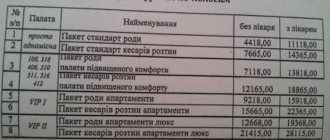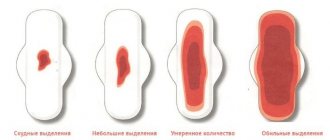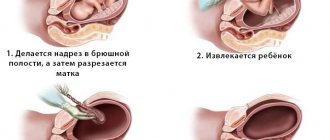A caesarean section is performed according to planned and emergency indications; in Russia it is almost impossible to do it at the woman’s request: legal norms do not prohibit elective caesarean section, however they do not give the woman in labor freedom of choice.
Operative childbirth involves significant risks to mother and baby during the operation itself and during the postpartum period. The risk of long-term consequences cannot be excluded. Therefore, such operations are carried out only if there are compelling reasons. There are also contraindications for cesarean section.
If you choose, you can have a surgical birth in some countries (France, Georgia, China, France and others); they are very popular in America. Abroad, a woman enters into an agreement that specifies the possible consequences. The operation is carried out for a fee.
In Russian private clinics it is also possible to perform a caesarean section, however, due to legal vulnerability from the possible negative consequences of such an operation without indications, it is not performed only at the request of the mother.
Is it possible to have a caesarean section of your own free will?
Caesarean section can be done at one's own request in many countries, but in Russia this operation will be performed only if indicated. They are planned and emergency.
| Planned | Emergency |
Absolute readings:
Relative:
|
|
Planned indications are determined long before the expected birth during the examination of the pregnant woman. Often, even before pregnancy, the expectant mother already assumes possible prospects based on her state of health.
If the patient develops complications during childbirth that threaten the life and health of the child, then a cesarean section will be performed for emergency reasons to save the mother and baby.
We recommend reading about what a caesarean section is. From the article you will learn how the operation is performed, types of cesarean section, consequences, and recovery period. And here you can read more about the pros and cons of a cesarean section.
Legal aspects
According to Law 323 of the Federal Law “On the Fundamentals of Protecting the Health of Citizens,” a woman has the right to provide medical care in the required volume, and medical workers are obliged to provide this assistance within the limits of their qualifications and competence. Also, the patient has the right to choose a doctor and a medical organization.
However, with regard to the cesarean operation, its implementation is regulated by the Letter of the Ministry of Health of 2014 No. 15-4/10/2-3190, which specifies all the indications for this procedure. The letter is advisory in nature and does not prohibit the doctor from performing an operation at the woman’s request.
But medical workers are responsible for the life and health of the mother and child and will not resort to such an operation without compelling reasons specified in the document. A woman does not have the right to demand a cesarean section only at her own request, and the doctor has the right to refuse the operation if no indications for its implementation are identified.
Elective, that is, at will, caesarean section in Russian legislation is not listed as one of the rights of citizens to medical care. If the doctor performed a caesarean section without indications, he will bear criminal and administrative liability in the event of complications developing in the woman or child in full, so medical workers do not take such a risk.
Price for surgical delivery
If a woman has an indication for surgery, it will be performed free of charge in public hospitals. In private clinics, the cost of the service ranges from 50 to 300 thousand, depending on additional options: pregnancy management, tests, an individual ward, courses for pregnant women, joint childbirth with the father, postpartum rehabilitation. Anesthesia, cosmetic stitches and medications are paid separately.
In foreign clinics, the cost of the operation will be much higher.
| A country | Price in thousands of dollars as of August 2019 |
| USA | 7-10 |
| England | 12-15 |
| France | 20-30 |
| Germany | 10-20 |
| Israel | 12-30 |
| Spain | 6-8 |
| Czech | 6-8 |
| Switzerland | 30 |
| Austria | 10 |
| Canada | 30-40 |
| Thailand | 3 |
The cost of treatment should also include the period of residence in the country before and after childbirth, which is necessary for preparation for surgery and postoperative rehabilitation, as well as subsequent preparation of legal documents.
Consequences of the operation for mother and child
Nature predetermines the natural process of childbirth. Contractions signal the time for the baby to be born. With the natural birth method, the fetus has to pass through the birth canal, which helps squeeze out excess fluid from the lungs and make breathing easier.
When born surgically, a longer adaptation of the baby to the outside world occurs. He is not prepared for new conditions, it is more difficult for him to breathe and scream. The breathing rate of such a baby is lower than that of a naturally born one, and the volume of the lungs is reduced by a third. There is a high probability of developing pneumonia.
The effect of general anesthesia during surgery can also contribute to passivity. The child is born lethargic, with low muscle tone. He sucks poorly or refuses it completely.
It has been established that such children are at risk of developing respiratory failure. They are more susceptible to diseases and disorders of the gastrointestinal tract than children who were born naturally. With a caesarean section, there is a high risk of complications for the baby.
Due to a sudden change in pressure, a cerebral hemorrhage can occur. Children often experience high intracranial pressure.
Children have low hemoglobin, do not gain weight well, and are more likely to suffer from intestinal diseases. They are more likely to have allergic reactions.
In addition, children have hyperactivity syndrome. They may have psychological problems and lag behind their peers in development.
The consequences of a cesarean section can also cause complications for the woman in labor. A caesarean section can cause a lot of blood loss as tissue is cut and blood vessels are damaged.
As a result of surgery, adhesions appear. If there are a large number of them, disruption of the functioning of internal organs may occur. During the operation, pathogenic microbes may enter the uterine cavity. This contributes to the development of endometritis in a woman.
After surgery, complications of suture healing sometimes occur. These may be hematomas, purulent inflammation, suture dehiscence and bleeding. Violations may appear after some time in the form of ligature fistulas, colloid scars or hernia.
The use of anesthesia and painkillers can also negatively affect the health of the mother. This can be expressed in the following:
- rapid drop in blood pressure;
- disorders of the cardiovascular system;
- neuralgic diseases;
- the appearance of severe back pain.
The operation is painless, but in the postoperative period the woman in labor experiences severe pain. She can't get out of bed for several days. After the operation, the mother will be able to simply hold the baby in her arms later than during an independent birth. Problems arise in subsequent pregnancies.
Where is caesarean performed at the request of a pregnant woman?
At the request of a pregnant woman, caesarean sections are performed in France, Spain, and the USA. The Italians were the pioneers. Then the fashion for elective caesarean sections spread to the United States of America, where the percentage of operations reaches its maximum.
But before this, the woman enters into a huge contract, which spells out all the possible complications and risks associated with the operation. In America, the interaction between doctors and patients regarding possible claims in this case is strictly regulated.
In Asia, the leading participants in the voluntary operation were Japan, South Korea and China. However, in recent years, natural childbirth has become increasingly practiced in Japan, and even the choice of anesthesia is limited to women. In all countries, the operation is paid; a complex contract is drawn up in advance, taking into account all the likely outcomes of the intervention for both the mother and the child.
C-section
How is a CS performed?
A CS is a surgical method of delivery that involves removing the baby from the uterus through an incision in the abdominal wall. The operation requires certain preparation. The last meal is allowed 18 hours before surgery. Before the CS, an enema is given and hygiene procedures are carried out. A catheter is inserted into the patient’s bladder, and the abdomen is necessarily treated with a special disinfectant.
The operation is performed under epidural anesthesia or general anesthesia. If the CS is done according to plan, then doctors are inclined to use an epidural. This type of anesthesia assumes that the patient will see everything that is happening around, but will temporarily lose tactile and pain sensations below the waist. Anesthesia is given through a puncture in the lower back where the nerve roots are located. General anesthesia during surgical childbirth is used urgently, when there is no time to wait for regional anesthesia to take effect. The operation itself consists of the following steps:
- Abdominal wall incision. It can be longitudinal and transverse. The first is intended for emergency cases, because it makes it possible to get the baby as quickly as possible.
- Muscle extension.
- Uterine incision.
- Opening of the amniotic sac.
- Extraction of the baby, and then the placenta.
- Suturing the uterus and abdominal cavity. For the uterus, self-absorbable threads must be used.
- Applying a sterile dressing. Ice is placed on top of it. This is necessary to increase the intensity of uterine contractions and reduce blood loss.
In the absence of any complications, the operation does not last long - a maximum of forty minutes. The baby is taken out of the mother's womb in the first ten minutes.
There is an opinion that caesarean section is a simple operation. If you don’t delve into the nuances, it seems that everything is extremely easy. Based on this, many women in labor dream of a surgical method of delivery, especially considering the effort natural childbirth requires. But you should always remember that a coin cannot have one side.
How to achieve without testimony
It is almost impossible to achieve a caesarean section without indications on the territory of the Russian Federation. You can ask to perform the operation yourself only if there are relative indications in which there is a high chance of complications in natural childbirth for mother and child.
A refusal may be obtained due to the fact that medical workers are not protected from claims from patients in the event of harm to health during an operation without indications. But the protection of patient rights in Russia is more developed: a woman’s wrong choice in favor of surgery will not be taken into account in legal proceedings. The doctor is only obliged to convince the woman in labor that natural childbirth, in the absence of contraindications, will be better than surgical birth.
Why is a caesarean section attractive to a woman?
Nowadays, there is a desire among pregnant women for elective (selective) childbirth using cesarean section without indications for this operation.
Why is this so attractive to them? The desire of women to “give birth” to a child through a caesarean section is attracted primarily by the relief from tedious efforts and severe pain. During surgical operations there are no ruptures or other damage to the mother’s genital organs.
A significant role in choosing this method is also played by the rapid birth of the child and the absence of birth injuries. In addition, during the operation, a woman is sometimes given the opportunity to choose the date of birth of the child. But this “easy” method also has a downside.
Advantages of caesarean section at the woman's request
A caesarean section at the request of the woman in labor may have the following advantages:
- choosing a specific due date;
- anesthesia and anesthesia;
- low risk of injury to the child during childbirth;
- there is no chance of injuring the birth canal;
- the birth canal does not stretch;
- psychological comfort of the mother.
Pain relief during childbirth
Choosing surgery without indications does not have any particular health benefits. This type of childbirth has a positive effect on the psychological state of a woman if she has fear of the natural process.
When is a CS necessary?
The attending gynecologist will decide whether the woman in labor needs surgery.
In most cases, a CS is planned. The doctor determines whether there are any threats to the mother and baby if the birth takes place naturally. The obstetrician then discusses delivery options with the mother. A planned CS is performed on a predetermined day. A few days before the operation, the expectant mother should go to the hospital for a follow-up examination. While the pregnant woman is scheduled to be in the hospital, the doctor monitors her condition. This allows us to predict the likelihood of a successful outcome of the operation. Also, the examination before the CS is aimed at determining the full-term pregnancy: using various diagnostic methods, it is revealed that the baby is ready for birth and there is no need to wait for contractions.
The operation has a number of indications. Some factors leave room for discussion about the method of delivery, others are absolute indications, that is, those in which ER is impossible. Absolute indications include conditions that threaten the life of the mother and baby during natural delivery. CS must be done when:
- absolutely narrow pelvis;
- presence of obstructions in the birth canal (uterine fibroids);
- failure of the uterine scar from previous CS;
- thinning of the uterine wall, which threatens its rupture;
- placenta previa;
- foot presentation of the fetus.
There are also relative indications for CS. Given these factors, both natural and surgical childbirth are possible. The delivery option is selected taking into account the circumstances, the health and age of the mother, and the condition of the fetus. The most common relative indication for CS is breech presentation. If the position is incorrect, the type of presentation and the gender of the baby are taken into account. For example, in the breech-foot position, ER is acceptable, but if they are expecting a boy, the doctor insists on a cesarean section to avoid damage to the scrotum. With relative indications for cesarean section, the correct decision regarding the method of birth of the baby can only be suggested by an obstetrician-gynecologist. The parents’ task is to listen to his arguments, because they will not be able to assess all the risks on their own.
Caesarean section can be performed on an emergency basis. This happens if labor began naturally, but something went wrong. An emergency CS is performed if bleeding begins during natural delivery, premature placental abruption occurs, or acute hypoxia is detected in the fetus. An emergency operation is performed if labor is difficult due to weak contractions of the uterus, which cannot be corrected with medication.
Sources
- https://VseProRebenka.ru/rody/kesarevo-sechenie/kesarevo-po-zhelaniyu.html
- https://40-nedel.ru/991-Vozmozhno-li-kesarevo-po-zhelaniyu-zhenshchiny.html
- https://kesarevo-sechenie.ru/mozhno-nelzya/po-sobstvennomu-zhelaniju
- https://JdemBaby.com/rody/cesarean/kesarevo-po-sobstvennomu-zhelaniyu.html
[collapse]
Why don't they do cesarean sections at will?
Caesarean sections are not performed voluntarily, since the operation itself is very stressful for both the woman and the child, especially if it is not necessary. The risk of early and long-term complications increases for mother and child.
| Complications in the mother | Complications in a child |
|
|
Advantages and disadvantages of CS
Caesarean section is an abdominal operation, as a result of which a child is born. A distinctive feature of the procedure is the immersion of the woman in labor into an unconscious state using general anesthesia. An incision is made in the lower abdomen and uterus.
The advantages of this type of delivery include the following:
- absence of pain and stress in women;
- the possibility of preventing postpartum complications;
- absence of birth injuries;
- the duration of the operation is less than natural childbirth;
- it is possible to pre-select the date and time of birth of the baby;
- the situation is completely under the control of medical personnel.
The disadvantages of a cesarean section are much greater than the advantages. This is due to the high degree of trauma of the procedure.
Among the disadvantages of the operation are:
- long recovery period;
- high probability of infection in the uterus;
- prohibition on lifting weights in the first 3 months;
- high risk of heavy blood loss;
- danger of seam divergence;
- The next pregnancy is allowed to be planned no earlier than one year after the intervention.
For a baby to be born by caesarean section is considered unnatural. The risk of slower physical development increases. There may also be problems with the process of opening the lungs. In some cases, difficulties with digestion and metabolic processes appear. It is believed that babies born by Caesarean have a weakened immune system.
Contraindications for surgery
Caesarean surgery has relative contraindications, which are associated with the risk of purulent-septic complications in the postoperative period in the mother and fetus:
- acute or exacerbation of chronic diseases in a pregnant woman (pneumonia, pyelonephritis, ARVI);
- immunodeficiency states;
- labor lasts more than 24 hours;
- the duration of the water-free period is more than 12 hours;
- frequent manual and instrumental vaginal examinations (more than five);
- unfavorable epidemiological situation in the obstetric hospital;
- intrauterine death and fetal asphyxia, when there is no certainty of the birth of a living child;
- deep prematurity, incompatible with life;
- congenital deformities of the fetus incompatible with life;
- failed attempt at vaginal delivery (vacuum extraction, application of obstetric forceps);
- impossibility of administering anesthesia due to widespread allergies or the woman’s health condition.
During childbirth, the ratio of risks from the operation and from refusal to perform it is taken into account. If women wish, contraindications are taken into account as absolute. Also, to perform an operation in Russia, the patient’s informed voluntary consent is required.
We recommend reading the article about elective caesarean section. From it you will learn how long it takes to perform a cesarean section, preparation, how long the operation takes, what to do when the cesarean section is performed. And here is more information about how the third caesarean section takes place.
Caesarean section is a serious operation that should only be performed when indicated. However, in a number of countries (Asia, Europe, America), a woman’s desire is sufficient for prompt delivery. In the Russian Federation, caesarean sections are performed only when indicated.
Legal aspects of the operation
To understand whether it is possible to do a caesarean section at your own request, it is necessary to consider the legal side of the issue. There is no official ban on surgical intervention. The decision is made by the doctor. He weighs the possible risks and evaluates the benefits of the choice.
Is it possible to have a caesarean section without indications?
The law does not prohibit sending a patient for surgical delivery in the absence of serious indications. But not every doctor will give official consent to the procedure. An emergency caesarean section is performed in case of unexpected complications during childbirth. Planned surgery is not performed unless absolutely necessary.
If a woman decides to have an artificial birth on her own, she undergoes an elective caesarean section. This type of operation involves signing an official multi-page document. It describes the possible consequences of the intervention. By signing the document, the mother in labor takes responsibility for the outcome of the birth.
Reasons for refusal
The doctor has the right to refuse to perform a cesarean section in the absence of compelling reasons for doing so. The motivation for refusal is the woman’s good health. Before making a final decision, the gynecologist will try to convince the patient to refuse the operation on her own. She should understand that she is causing potential harm to her own child.
The decision on the method of delivery is made taking into account the results of tests and ultrasound examinations. The presence of edema, toxicosis and general well-being are also taken into account.
Useful video
Watch this video about why elective caesarean sections should not be allowed:
Similar articles
- What is better - cesarean or natural childbirth, statistics...
How to figure out what is better - cesarean or natural childbirth. When will the doctor choose a natural birth and when will he refer you for a cesarean section? What are the advantages and disadvantages of each type of delivery. What will be prescribed after 40, for eye disease, diabetes. Read more - Planned caesarean section: preparation, when to do it...
What you should know and what to prepare for if there is a planned cesarean section. At what time is the operation performed, what preparation is required at home and in the maternity hospital. The course of the operation, its features, how long it takes to perform a planned caesarean section, when they are admitted to the maternity hospital. How is it different from emergency? Read more
- Caesarean section: pros and cons of surgery for mom...
What is the danger of a caesarean section, the pros and cons of it. Why is it bad for mother and child? Which is better - cesarean or natural childbirth and why. Read more
- Caesarean section: how it is done, what stitches there are...
What you need to know if you have a caesarean section. What are the surgical options and types of incisions? How the CS goes, preparation and recovery after. What are the consequences for the mother and caesareans? Important features of the first and second cesarean section. Read more
- Third caesarean: is it possible to get pregnant, how does it go...
What are the features of the third cesarean section? Is it possible to get pregnant and when is it better - in half a year, in a year or two. How does a CS proceed after two operations? At what time is a caesarean section performed? Why is caesarean section dangerous and what preparation is needed? Read more
The reverse side of a “custom” CS
Many expectant mothers do not see anything wrong with a caesarean section if the woman wishes. The operation appears to them as a simple procedure, where the woman in labor falls asleep and wakes up with a baby in her arms. But those women who have gone through surgical childbirth are unlikely to agree with this. The easy path also has a downside.
It is believed that CS, unlike ER, is painless, but this is not true. In any case, this is an operation. Even if anesthesia or anesthesia “turns off” the pain during surgical delivery, it returns afterwards. Departure from the operation is accompanied by pain at the suture site. Sometimes the postoperative period becomes completely unbearable due to pain. Some women even suffer from pain for the first couple of months after surgery. Difficulties arise in “maintaining” oneself and the child: it is difficult for the patient to get up, take the baby in her arms, and feed him.
Possible complications for the mother
Why is caesarean section performed in many countries solely according to indications? This is due to the possibility of complications after surgery. Complications affecting the female body are divided into three types. The first type includes complications that may appear after surgery on internal organs:
- Major blood loss. With CS, the body always loses more blood than with EP, because when tissue is cut, blood vessels are damaged. You can never predict how the body will react to this. In addition, bleeding occurs due to pregnancy pathology or disruption of the operation.
- Spikes. This phenomenon is observed during any surgical intervention; it is a kind of protective mechanism. Usually adhesions do not manifest themselves, but if there are a lot of them, then a malfunction of the internal organs may occur.
- Endometritis. During the operation, the uterine cavity “comes into contact” with air. If pathogenic microorganisms enter the uterus during surgical childbirth, a form of endometritis occurs.
After a CS, complications often appear on the sutures. If they appear immediately after the operation, the doctor who performed the CS will notice them during the examination. However, suture complications do not always make themselves felt immediately: sometimes they appear only after a couple of years. Early suture complications include:
- Doctors recommend wearing a special bandage that will help restore
bleeding; - hematomas;
- purulent processes and inflammation;
- seam divergence.
Late complications after cesarean section include ligature fistulas, hernias, and keloid scars. The difficulty in determining such conditions lies in the fact that after some time women stop examining their stitches and may simply miss the formation of a pathological phenomenon.
It is generally accepted that anesthesia can affect the condition of a Caesarean baby, however, painkillers and anesthesia often cause complications in the patient. These include:
- disruptions in the functioning of the heart and blood vessels;
- aspiration;
- throat injuries from insertion of a tube through the trachea;
- a sharp decrease in blood pressure;
- neuralgic complications (severe headache/back pain);
- spinal block (when using epidural anesthesia, severe spinal pain occurs, and if the puncture is incorrect, breathing may even stop);
- poisoning by toxins from anesthesia.
In many ways, the occurrence of complications depends on the qualifications of the medical team that will perform the operation. However, no one is immune from mistakes and unforeseen situations, so a woman in labor who insists on a caesarean section without indication should be aware of the possible threats to her own body.
What complications can a child have?
Caesarean babies are no different from babies born naturally.
Doctors do not undertake to perform a Caesarean section at will (in the absence of indications) due to the likelihood of complications in the baby. CS is a proven operation that is often resorted to, but no one has canceled its complexity. Surgical intervention can affect not only the female body, but also affect the health of the baby. Complications of cesarean section concerning the child can be of varying degrees.
With the natural method of birth, the baby goes through the birth canal, which is stressful for him, but such stress is necessary for the baby to adapt to the conditions of a new life - extrauterine. With CS there is no adaptation, especially if the extraction occurs according to plan, before the onset of contractions. Violation of the natural process leads to the fact that the baby is born unprepared. This is a huge stress for a fragile body. CS can cause the following complications:
- depressed activity from drugs (increased drowsiness);
- breathing and heartbeat disturbances;
- low muscle tone;
- slow healing of the navel.
According to statistics, “caesareans” often refuse to breastfeed, plus the mother may have problems with the amount of milk. We have to resort to artificial feeding, which leaves its mark on the baby’s immunity and its adaptation to the new environment. Children born by cesarean section are more likely to suffer from allergic reactions and intestinal diseases. “Caesareans” may lag behind their peers in development, which is due to their passivity during labor. This manifests itself almost immediately: it is more difficult for them to breathe, suck, or scream.
Indications
There are absolute and relative indications for cesarean section. Absolute indications include those situations in which natural childbirth is impossible or is dangerous to the life of the mother and fetus. Relative indications include diseases and obstetric situations in which vaginal delivery is possible, but with a greater risk for the mother and fetus than a cesarean section.
Absolute indications include:
1. Narrowing of the pelvis of III-IV degree, or its deformation due to injuries or other reasons, creating obstacles to the advancement of the fetus.
2. Tumors of the cervix, pelvis, ovaries, bladder, creating mechanical obstacles to the birth of a fetus through the natural birth canal.
3. Cancer of the cervix, vagina, external genitalia, rectum, bladder.
4. Placenta previa.
5. Presentation and prolapse of umbilical cord loops.
6. Premature abruption of a normally located placenta in the absence of conditions for urgent delivery through the natural birth canal, with heavy bleeding.
7. Incorrect insertion of the head (frontal presentation).
8. Eclampsia.
9. Severe varicose veins of the vagina and external genitalia.
10. Threatening uterine rupture.
11. Transverse or oblique position of the fetus.
Relative readings:
1.Narrowing of the pelvis I-II degree in combination with other unfavorable factors (large fetus, post-term pregnancy, etc.).
2. A scar on the uterus after a cesarean section (although this is a relative indication, very few doctors in the world decide to conduct a vaginal birth after a previous operation).
3. The onset of fetal hypoxia.
4. Breech presentation of the fetus.
5. Multiple pregnancy.
6. Post-term pregnancy when the body is not ready for childbirth.
7. Primipara, 30 years old.
8. Pregnancy resulting from assisted reproductive technologies (IVF), history of infertility.
9. Malformations of the uterus.
10. Chronic diseases of the mother (for example, heart defects, diabetes, myopia).
11. HIV infection in the mother.
Most often, the decision in favor of a cesarean section is made in the presence of several relative indications (for example, breech presentation in combination with a large fetus, or a primiparous woman over 30 years of age whose pregnancy occurred after IVF).
Benefits of natural childbirth
Childbirth through the natural birth canal is more physiological for both mother and child, since it occurs at the moment when both of them are ready for it.
A caesarean section leaves a mark for life in the form of a scar on the uterus. 95% of women with a uterine scar undergo a repeat cesarean section and are not able to give birth on their own. Adhesive disease may occur (“adhesions” are connective tissue that can grow in the abdominal cavity and “seal” intestinal loops, ovaries, fallopian tubes, which can cause pain, constipation, and infertility in the future).
After a natural birth, a woman’s body recovers faster, the postpartum period is easier, so medications are required much less frequently, and discharge occurs faster. The mother stays with the baby almost immediately after birth and can feed him on demand.
Although a cesarean section frees you from labor pain, after a cesarean section a woman experiences intense pain in the area of the postoperative suture, and it is impossible to do without painkillers. After a natural birth, even if stitches were placed in the perineum, pain relief is not required in most cases.
The fact that a caesarean section helps preserve your figure is also a myth. The abdominal wall is stretched during pregnancy, not during childbirth, and in the presence of a suture, its tone is restored worse. The reverse development of the uterus after a cesarean section also occurs more slowly, so postpartum discharge continues longer.
Many people believe that after a cesarean section, problems with urination, uterine prolapse, and hemorrhoids occur less frequently, but this is not true, since the load on the genitals occurs not only during childbirth, but throughout pregnancy. However, it should be recognized that with a caesarean section there is no stretching of the vagina, so it remains narrower than after a natural birth.
Some women consider the advantage of a cesarean section to be that they can choose their due date. But this is also not entirely true, because no one is protected from the premature onset of labor before the scheduled date of the operation. In addition, you can choose a date only to the extent that the condition of the mother and child allows.










